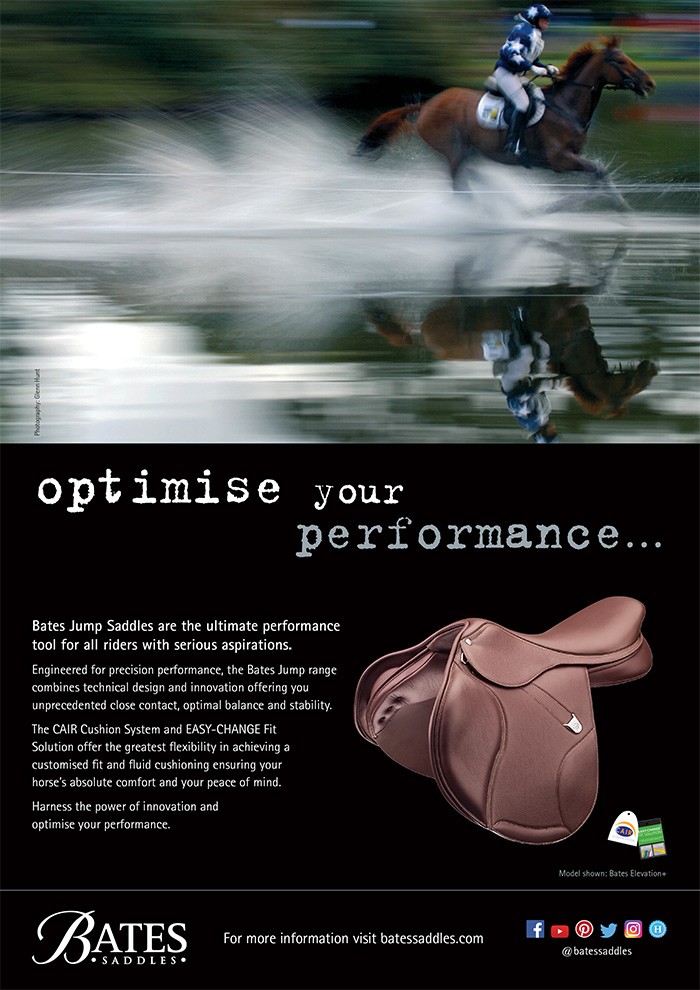
George Morris in 2009, same simple, but not easy truths. Christopher Hector wrote the words and Ros Neave took the pix
The intermediate group was a very mixed bag of showjumpers and eventers. Chris Chugg on his next star, Conquistador, Vicki Roycroft on Infatuation and the next big thing in Australian showjumping, 15 year old Tom McDermott riding Merewah, Ben Blay, a reserve for the Youth Olympic showjumping team on his nine year old, Ryles, and the eventers, Stuart Tinney riding the River Dance son, Kinnordy Rubino, Peter Gillis and Mister JJ , Emma Mason and Pharinelli, and Fiona John and Denali Blue.
Not surprisingly George Morris does not like the Australian eventers tendency to nag with their legs:
“Your legs signal for the horse to go forward. Don’t tap every stride. Your legs hang passive – if the horse drops back, your legs close. If the horse is sluggish, add reinforcements from the cluck to the spur to the whip. If I think trot and I don’t get it, then I go to the stick or the spur. Tapping and kicking is not only unsightly, it is making your horse dead to the leg. If the horse is in front of your leg, it shows in two qualities. The first is regularity and the second is impulsion.”
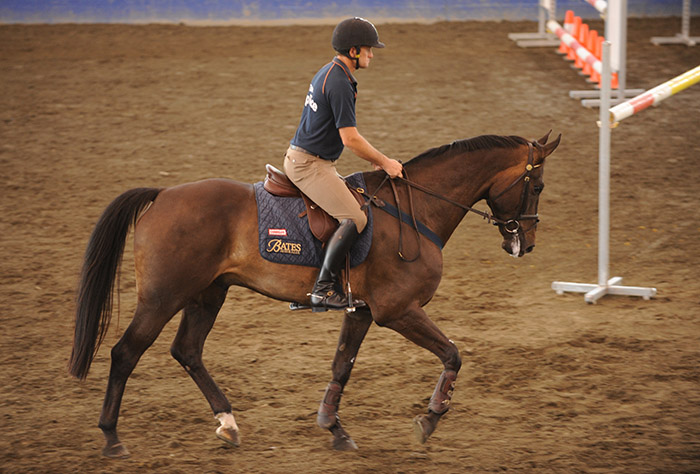
“If the horse is in front of your leg, it shows in two qualities. The first is regularity and the second is impulsion.”
“What is an indication your horse is in front of your legs? He is PULLING. As the French say ‘in the hand’. If the horse is walking, we have say three pounds in the hand, slow trot, three to five, posting trot five pounds, canter, ten pounds, gallop, 15 to 20 pounds. Keep this sport simple. Is the horse on the bit? Is he in front of the legs? Is he pulling?? The horse has to be in the hand to jump a fence. If you have a taut rein, that is correct – if the rein is about to break, that’s too much – but close your fingers and take a definite contact.”
more wisdom follows
George Morris is of a generation of horseman for whom the school figures were the grammar of equitation, and he is outraged when most of his riders demonstrate a total ignorance of the difference between a half turn, and a half turn in reverse.
“You have to learn these basic figures you stupid things!”
George laughs at his own ferocity: “See if I got too nice you wouldn’t recognize me…”
Just so you won’t ever be caught out, this is the difference:
“The beauty of teaching riding is training the basics. The basics are simple. We make it complicated when we don’t know, we have to simplify what we do and make it very simple because you can’t jump unless the horse is in front of your legs and pulling. In front of that big water at Aachen, I want the horse pulling my arms out…”
“For the beginner it is enough to take contact and feel the pull. The next step is more complicated, the horse comes through the hand, there is flexion in the hand.”
“The great beauty Eric Lamaze taught us in Hong Kong, was jumping with the motion. You don’t have to play catch up with the horse, you are with the horse way before the jump then you don’t have to do anything at the jump except relax your hands.”
The best index of a rider’s skill is his hands. Hands not only reflect independence of seat and legs (balance) but also the sympathetic feeling of communication between horse and rider.
George Morris, Hunt Seat Equitation, p 134
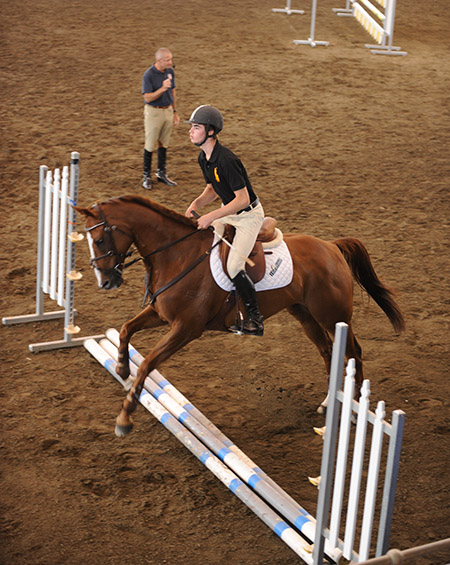
Tom McDermott staying there over the pole
And the riders had to show this quality over the pole: “Stay there over the pole. I don’t care what the horse does, just stay there, don’t jump it, the horse jumps it.
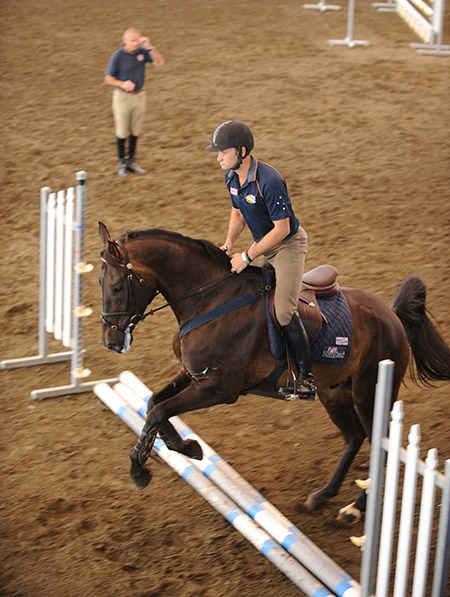
Stuart Tinney shows how to stay there
You have a bad habit of getting in front of the horse and that’s why they jump so small. This habit is often created by doing the work of the hands with the upper body. The riders don’t move their hands, they don’t use a release.
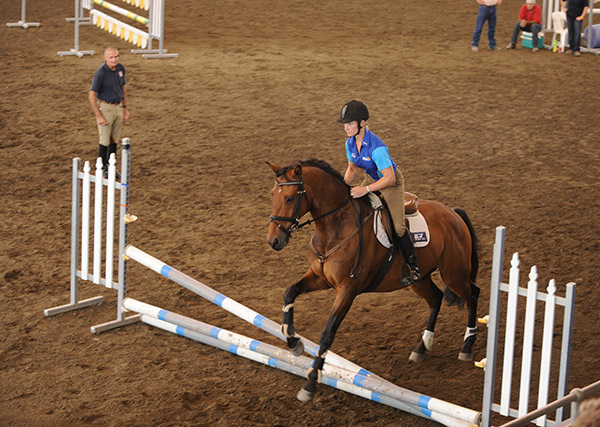
Eventer Emma Mason
What follows the horse is the rider’s arms not the crotch or the seat. 50% of you jump ahead of the horse, it’s an epidemic. The work of the upper body should be the work of the hands. When you use a release correctly your hands do the work of the upper body.”
next George demonstrates

Australia RRP $159.95, (click here to find your nearest stockist) https://goo.gl/3dbzNb
New Zealand RRP $169.90, (click here to find your nearest stockist) https://goo.gl/BG2fyL
George demonstrates this, jumping the fence with his hands locked on the horse, his upper body ducking forward: 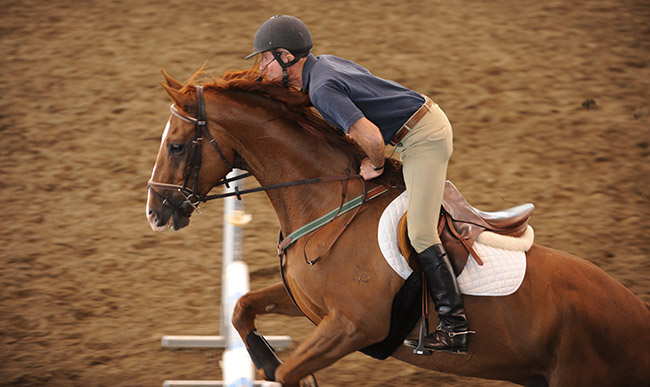
“Now watch the difference when I soften and move my hands. I didn’t throw the reins up around his eyeballs – I HOPE I didn’t…”
“You must work on your releases. Do it with a short release, just two inches. What do I do with my hands? Just rest them. Rest your hands an inch or two up the neck, don’t throw your hands, rest them and don’t open your hands. Slipping the reins is an insidious disease. The only time you slip the reins is at a big drop fence. It isn’t legs, it isn’t seat, it isn’t hands, it’s BRAINS. Think, think, think.”
Release of the horse’s mouth at the moment of take-off must become so imperceptible and subtle that it takes a trained eye to see it function. The hand, rather than abandoning the horse in the air, must now support and maintain a light, following feel during flight. The kind of feel one describes as a ‘feathery touch.’
George Morris, Hunter Seat Equitation, p 134
“As teachers you have to be scrupulous – like a microscope on every detail. It’s the simplest things. Lovely Beezie Madden is so humble. Tell her the simplest thing and she’ll accept it gracefully because she has absolutely no ego.”
It was time to work on straightness: “Here we have drifters, most horses drift.”
So George stood in front of the jump, and as the riders came over, pointed either left or right: “Take the fence at a trot, and as you jump, I’m going to point and you are going to turn.” And turn they did, and straightened they were.
Now the lines were getting interesting. A vertical, six to an oxer, round the corner to the wall, a bending three to an oxer with barrels, and a direct six to another vertical.
And there was no mercy to the rider who was rough with their horse: “Discipline the horse, don’t get rough, don’t get irritated, don’t have a short fuse. Corrections have nothing to do with emotion. Caress you horse with your right hand, this is not good for the horse, it is good for the rider. This is not training it is developing the empathy of the rider with the horse. Now caress your horse with your whip up its neck.”
“When I ride your horses and stop in a corner and they freak out. My horses don’t freak out, they trust and respect me. The horse absolutely mustn’t look back and fear the rider. The best horsemen are cold blooded horsemen – hot horsemen are limited horsemen. The best riders are cold, they don’t have emotion attached to the sport.”
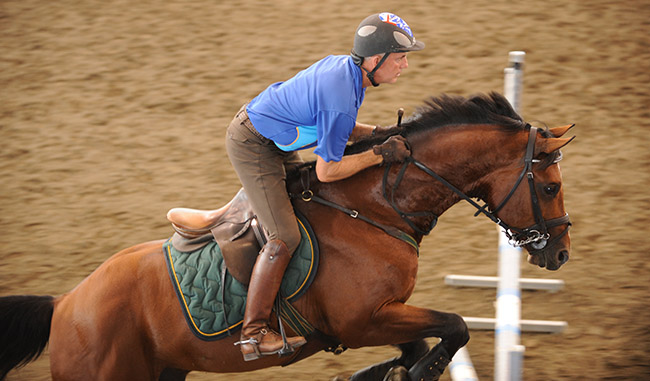
“The jump will be a result of the rider’s position. I don’t change the horse, I change the rider.”
By now the line had reached its final form. Vertical, six to an oxer, round the corner to the wall, bending three to the barrels, direct six to the vertical, round the corner to the triple, two to an oxer, one stride, vertical, and a direct three to the Liverpool.
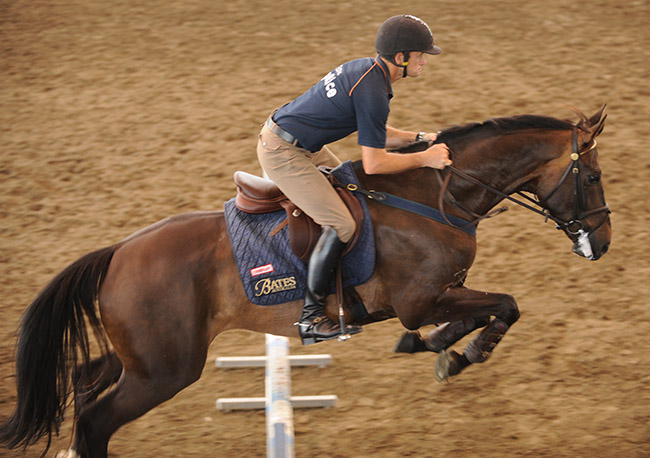
“Stuart your horse really needs to bend between the wall and the barrels, you’ve got to give him a comfort zone.”
Out of the corner of his eye, George spotted Chris Chugg quietly schooling Conquistador. “Chuggie, stop, STOP, turn off the key…’
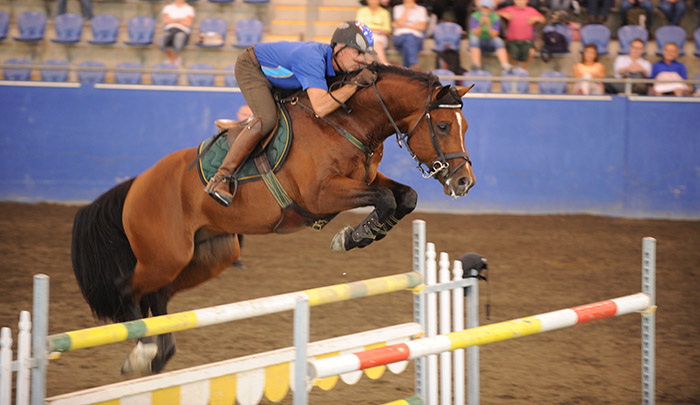
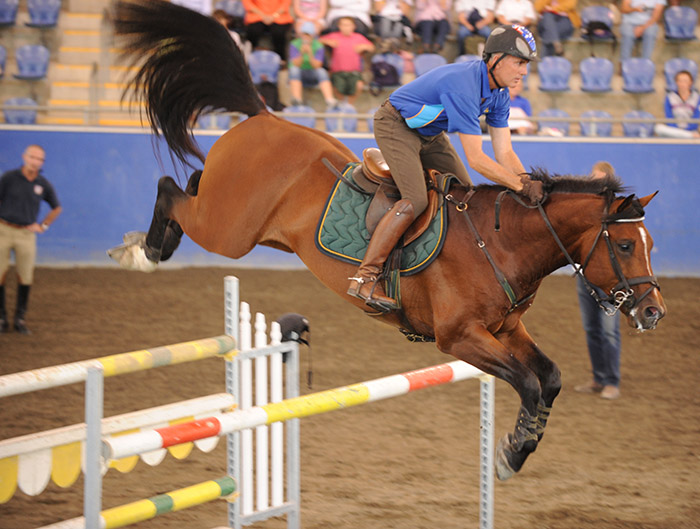
“You have to stretch if you are a good teacher or trainer. I stretch to the max. It can go wrong and you try to end on a good note but you must stretch. Especially for the eventer horses, what we are doing is a stretch but this is what event horses have to have if a system has merit, if a teacher has merit.”
“Great trainers are fanatical about basics. Legs without hands, then hands without legs. Think forward and they go. Work conscientiously without stirrups and the seat will be there. We don’t have to talk about it, legs and hands, not seat. Jimmy Williams was a very great jumping trainer, and he said, it’s what you learn after you think you know it all that counts… Tom, I’m talking to you, but you are young, life will teach you.”
Next month we catch up with George Morris at a new venue, the fabulous Roycroft jumping paddock at Mount White
Vicki Roycroft – The Organiser
Vicki Roycroft learnt quite a long time ago, just how valuable a lesson with George Morris can be…
“I first had a lesson in1986, when I was riding Apache. I think Susan Bond brought George out originally, and I helped Susan a little – he was doing the National Squad clinics. The first clinic he ever did was at Mulwala. I had Apache then, and at the show, I won the World Cup class with him. I had a bit of an ego and thought I had the sport by the short and curlies. I had the horse that was winning everything. We had the first clinic, the next day, and he tore strips off me. He gave me such a hard time. I came out of the clinic, almost in tears, thinking I can’t ride, I can’t ride, I’ve been wasting my time. I’d gone in with such an ego and came out thinking I can’t ride. I sat in the truck and I thought what am I going to do. Then I thought, bugger this. I can ride. I’m going to show this bastard I can ride.”
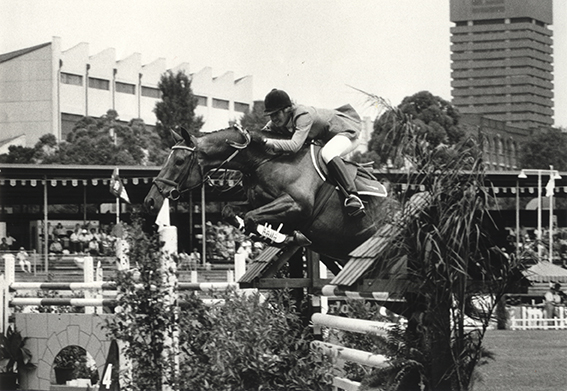
Vicki and Apache at Wentworth Park
“I came out the next day, and everything he said, I’d just stare him down, and everything he said, I did. The only problem I had, as I think you can see watching this clinic, I can’t count strides. If I try to count strides, I can’t see a distance to save my life. So I’ve really got to guess them. I was still getting into trouble for that, and I still do, but not as much trouble as I was in then. I realise now that I just toughed it out, and buckled down, no I’m going to show you I can ride. I didn’t realise then it was one of his tactics. I thought how can someone be so awful, and in those years he was a lot tougher. He’s mellowed considerably since then.”
“But that first time my reaction could have been the same as quite a lot of people – oh this stupid man, what’s he talking about. There have been riders who’ve taken that attitude in the past, but the results at the last two Olympics have shown who is right.”
“He is so passionate about the sport. I’ve been having lots of conversations with him over the last few days. Talking about how they planned for the gold medal at Hong Kong, and the thinking behind that, it’s just amazing. When the Americans had their low time, it was when they went away from his system. Earlier, when they had success, George was a selector, and I can remember him talking about the 1984 Olympics, and he said, ‘we chose Joe Fargis on a gut feeling, not because of his performance’ and of course, he went on to win individual gold, and the USA, team gold. Then they went with their legal challenges to a purely performance based process, which didn’t work, not the way they set it up anyway. It was long, strenuous and stressful… And it was only when the Americans were dragged back on the righteous path by George, that suddenly they were winning again. George dragged them back to Europe – he single handedly made them try for the Super League – when they won the Super League, I sent him a message – fabulous – because he made that happen. His thought processes, the way he thinks about the sport, it’s his all consuming passion. It’s wonderful when we get the opportunity to have him here. I’ve been trying to drag him back for a long time now. I had hoped that it might become an annual thing but now he has been returned to the American chef’s role, and I believe as a result of a unanimous vote of the riders.”
To me George seems to work on two distinct levels – one is ferociously verbal, and he talks about ideas and principles and drills the riders in them, but the other level, is the jumps themselves, the courses become educators…
“All the above – he thinks about it all before a clinic, then after a clinic he worries and thinks about what he could have done better. The clinics seem to go seamlessly but obviously there are things he thinks could have gone better.”
And the riders who do work hard on the flat, like Chris Chugg and Amanda Madigan, they have been the stars…
“Chugg is passionate about his sport and he wants to do very well. What I admire most is that he is not afraid to expose himself or his students to constructive criticism.”
This article originally appeared in the September 2009 edition of The Horse Magazine

